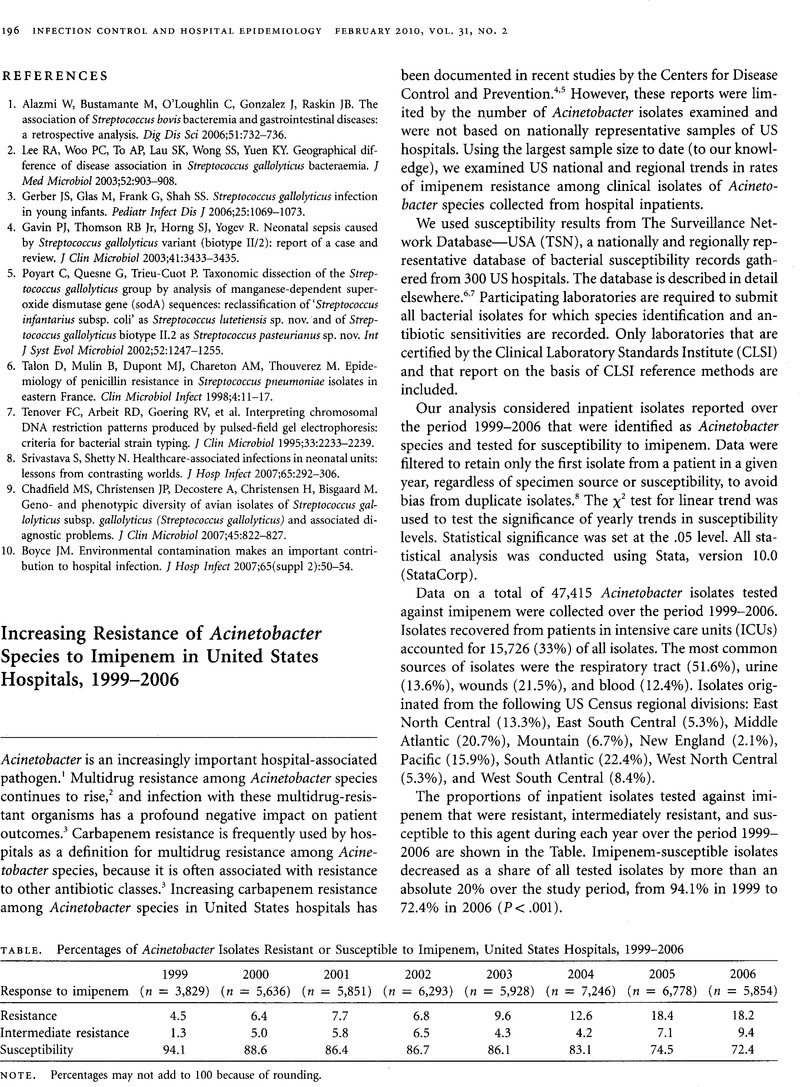Crossref Citations
This article has been cited by the following publications. This list is generated based on data provided by Crossref.
de Breij, Anna
Dijkshoorn, Lenie
Lagendijk, Ellen
van der Meer, Joke
Koster, Abraham
Bloemberg, Guido
Wolterbeek, Ron
van den Broek, Peterhans
Nibbering, Peter
and
Neyrolles, Olivier
2010.
Do Biofilm Formation and Interactions with Human Cells Explain the Clinical Success of Acinetobacter baumannii?.
PLoS ONE,
Vol. 5,
Issue. 5,
p.
e10732.
Diancourt, Laure
Passet, Virginie
Nemec, Alexandr
Dijkshoorn, Lenie
Brisse, Sylvain
and
Ahmed, Niyaz
2010.
The Population Structure of Acinetobacter baumannii: Expanding Multiresistant Clones from an Ancestral Susceptible Genetic Pool.
PLoS ONE,
Vol. 5,
Issue. 4,
p.
e10034.
Mera, Robertino M.
Miller, Linda A.
Amrine-Madsen, Heather
and
Sahm, Daniel F.
2010.
Acinetobacter baumannii 2002–2008: Increase of Carbapenem-Associated Multiclass Resistance in the United States.
Microbial Drug Resistance,
Vol. 16,
Issue. 3,
p.
209.
2011.
Combating Antimicrobial Resistance: Policy Recommendations to Save Lives.
Clinical Infectious Diseases,
Vol. 52,
Issue. suppl_5,
p.
S397.
Wisplinghoff, Hilmar
Paulus, Tobias
Lugenheim, Marianne
Stefanik, Danuta
Higgins, Paul G.
Edmond, Michael B.
Wenzel, Richard P.
and
Seifert, Harald
2012.
Nosocomial bloodstream infections due to Acinetobacter baumannii, Acinetobacter pittii and Acinetobacter nosocomialis in the United States.
Journal of Infection,
Vol. 64,
Issue. 3,
p.
282.
2012.
White Paper: Recommendations on the Conduct of Superiority and Organism-Specific Clinical Trials of Antibacterial Agents for the Treatment of Infections Caused by Drug-Resistant Bacterial Pathogens.
Clinical Infectious Diseases,
Vol. 55,
Issue. 8,
p.
1031.
Luo, Guanpingshen
Lin, Lin
Ibrahim, Ashraf S.
Baquir, Beverlie
Pantapalangkoor, Paul
Bonomo, Robert A.
Doi, Yohei
Adams, Mark D.
Russo, Thomas A.
Spellberg, Brad
and
Filion, Lionel G.
2012.
Active and Passive Immunization Protects against Lethal, Extreme Drug Resistant-Acinetobacter baumannii Infection.
PLoS ONE,
Vol. 7,
Issue. 1,
p.
e29446.
Lin, Lin
Tan, Brandon
Pantapalangkoor, Paul
Ho, Tiffany
Baquir, Beverlie
Tomaras, Andrew
Montgomery, Justin I.
Reilly, Usa
Barbacci, Elsa G.
Hujer, Kristine
Bonomo, Robert A.
Fernandez, Lucia
Hancock, Robert E. W.
Adams, Mark D.
French, Samuel W.
Buslon, Virgil S.
Spellberg, Brad
and
Pirofski, Liise-anne
2012.
Inhibition of LpxC Protects Mice from Resistant Acinetobacter baumannii by Modulating Inflammation and Enhancing Phagocytosis.
mBio,
Vol. 3,
Issue. 5,
Sun, Lova
Klein, Eili Y.
and
Laxminarayan, Ramanan
2012.
Seasonality and Temporal Correlation between Community Antibiotic Use and Resistance in the United States.
Clinical Infectious Diseases,
Vol. 55,
Issue. 5,
p.
687.
Lin, Lin
Tan, Brandon
Pantapalangkoor, Paul
Ho, Tiffany
Hujer, Andrea M.
Taracila, Magdalena A.
Bonomo, Robert A.
and
Spellberg, Brad
2013.
Acinetobacter baumannii rOmpA vaccine dose alters immune polarization and immunodominant epitopes.
Vaccine,
Vol. 31,
Issue. 2,
p.
313.
Schweizer, Marin L
Perencevich, Eli N
Eber, Michael R
Cai, Xueya
Shardell, Michelle D
Braykov, Nikolay
and
Laxminarayan, Ramanan
2013.
Optimizing antimicrobial prescribing: Are clinicians following national trends in methicillin-resistant staphylococcus aureus (MRSA) infections rather than local data when treating MRSA wound infections.
Antimicrobial Resistance and Infection Control,
Vol. 2,
Issue. 1,
p.
28.
Gandra, Sumanth
Braykov, Nikolay
and
Laxminarayan, Ramanan
2013.
East North Central Region Has the Highest Prevalence of Vancomycin-Resistant Enterococcus faecalis in the United States.
Infection Control & Hospital Epidemiology,
Vol. 34,
Issue. 4,
p.
443.
Klein, Eili Y.
Sun, Lova
Smith, David L.
and
Laxminarayan, Ramanan
2013.
The Changing Epidemiology of Methicillin-Resistant Staphylococcus aureus in the United States: A National Observational Study.
American Journal of Epidemiology,
Vol. 177,
Issue. 7,
p.
666.
Zilberberg, Marya D.
and
Shorr, Andrew F.
2013.
Prevalence of multidrug‐resistant pseudomonas aeruginosa and carbapenem‐resistant enterobacteriaceae among specimens from hospitalized patients with pneumonia and bloodstream infections in the United States from 2000 to 2009.
Journal of Hospital Medicine,
Vol. 8,
Issue. 10,
p.
559.
Braykov, Nikolay P.
Eber, Michael R.
Klein, Eili Y.
Morgan, Daniel J.
and
Laxminarayan, Ramanan
2013.
Trends in Resistance to Carbapenems and Third-Generation Cephalosporins among Clinical Isolates of Klebsiella pneumoniae in the United States, 1999–2010.
Infection Control & Hospital Epidemiology,
Vol. 34,
Issue. 3,
p.
259.
May, Larissa
Klein, Eili Y.
Rothman, Richard E.
and
Laxminarayan, Ramanan
2014.
Trends in Antibiotic Resistance in Coagulase-Negative Staphylococci in the United States, 1999 to 2012.
Antimicrobial Agents and Chemotherapy,
Vol. 58,
Issue. 3,
p.
1404.
Baig, Akeel
Cabral, Teresa M.
and
Corbett, Cindi R.
2014.
Development and Characterization of Monoclonal Antibodies for Rapid Detection ofAcinetobacter baumannii.
Monoclonal Antibodies in Immunodiagnosis and Immunotherapy,
Vol. 33,
Issue. 4,
p.
291.
Logan, Latania K.
Renschler, John P.
Gandra, Sumanth
Weinstein, Robert A.
and
Laxminarayan, Ramanan
2015.
Carbapenem-ResistantEnterobacteriaceaein Children, United States, 1999–2012.
Emerging Infectious Diseases,
Vol. 21,
Issue. 11,
p.
2014.
Giguère, Denis
2015.
Surface polysaccharides from Acinetobacter baumannii : Structures and syntheses.
Carbohydrate Research,
Vol. 418,
Issue. ,
p.
29.
Farhan, Rasheed
Raja, Kamran Afzal
and
Muhammad, Jan Leghari
2015.
-Lactam - -lactamase inhibitor combinations as the choice therapy for multidrug resistant Acinetobacter.
African Journal of Microbiology Research,
Vol. 9,
Issue. 2,
p.
78.



